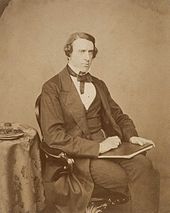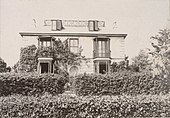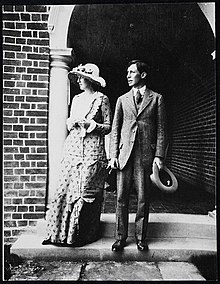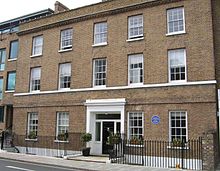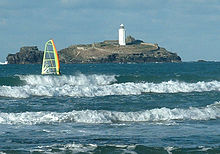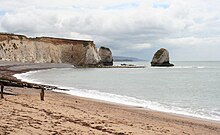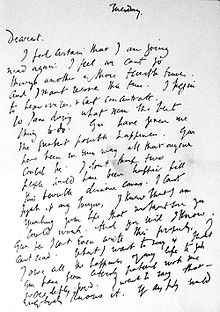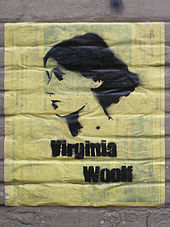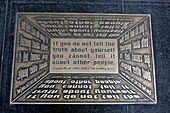Virginia Woolf
Virginia Woolf [ vəˈdʒɪnjə wʊlf ] ( London 25 January 1882 – Rodmell near Lewes , Sussex 28 March 1941 ; born Adeline Virginia Stephen ) was a British writer and publisher . She came from a wealthy intellectual family who had numerous contacts with writers. As a teenager she experienced the Victorian restrictions on girls and women. She was early as a literary critic and essayist active; her career as a novelist began in 1915 with the novel The Voyage Out . In the late 1920s she was a successful and internationally renowned writer. Woolf was rediscovered in the 1970s when her 1929 essay A Room of One 's Own became one of the most cited texts of the new women's movement . With her avant-garde work, she is one of the most important authors of classical modernism alongside Gertrude Stein .
Life
childhood and adolescence

Virginia Woolf was the daughter of the writer, historian, essayist, biographer and mountaineer Sir Leslie Stephen (1832-1904) and his second wife Julia Prinsep Jackson (1846-1895). She had three siblings: Vanessa Stephen (1879–1961), Thoby Stephen (1880–1906) and Adrian Stephen (1883–1948). There were also the half-sister Laura Makepeace Stephen (1870-1945) from her father's first marriage to Harriet Marion Thackeray (1840-1875) and the half-siblings George Herbert Duckworth (1868-1934), Stella Duckworth (1869-1897) and Gerald Duckworth ( 1870–1937) from her mother's first marriage to Herbert Duckworth (1833–1870). The family residence was in the London Borough of Kensington , 22 Hyde Park Gate. The intellectual and artistic elite of the time, such as Alfred Tennyson , Thomas Hardy , Henry James and Edward Burne-Jones , attended Leslie Stephen's salon.
Psychoanalysts and biographers describe that the half-siblings Gerald and George Duckworth abused Virginia or at least touched it more often and could have set one of the triggers for their manic-depressive illness, which is now known as bipolar disorder . Virginia herself only hinted at similar experiences in her autobiographical text, A Sketch of the Past , in keeping with the rigid Victorian era. Hermione Lee writes of Virginia Woolf in her biography: "The evidence is strong enough, but also ambiguous enough, to give rise to conflicting psychobiographical interpretations that paint very different accounts of Virginia Woolf's inner workings." Others, working more from a psychiatric perspective Scientists point to the genetic predisposition of her family. Virginia's father was known to suffer from attacks of self-doubt and symptoms of overwork, especially after the death of his wife, which manifested themselves in persistent headaches, insomnia, irritability and anxiety; The daughter later complained about similar complaints.
Virginia Stephen did not attend school but received private tuition from tutors and her father. She was impressed by her father's writing and his work as editor of the monumental work Dictionary of National Biography and by his extensive private library; therefore she expressed early on the desire to become a writer. When her mother died on May 5, 1895, thirteen-year-old Virginia suffered her first mental breakdown. Her half-sister Stella, who initially ran the household after Julia Stephen's death, married Jack Hills two years later and left home. Stella died a little later on their honeymoon from peritonitis .
From 1882 to 1894 the family spent summer holidays at Talland House , their summer home overlooking Porthminster Beach and Godrevy Point Lighthouse. It was in the small coastal town of St Ives , Cornwall , which became an artists' colony in 1928 . Virginia describes the situation in Sketched Memories :
“Our house was […] on the hill. […] It had an ideal view […] across the whole bay to the Godrevy lighthouse. On the slope of the hill there were small lawns framed by dense flowering bushes […]. You entered Talland House through a large wooden gate - [...] and then came to the right-hand side of the "Lugaus." [...] From the Lugausplatz you had a completely unobstructed view over the bay at that time."
In 1895 the house was sold to the Scottish painter Thomas Millie Dow . Virginia often returned to St Ives. She later described the location and nearby Godrevy Point lighthouse in Jacob 's Room and To the Lighthouse . London and St Ives will often be the setting for her work.
On June 26, 1902, Virginia's father was made a Knight Commander of the Bath . During this time, Virginia wrote and prepared various essays for publication. In January 1904, Virginia's first article for a women's supplement in the Guardian was printed. On February 22, 1904, the father died of cancer. This marked the end of a period of time for Virginia that was characterized by the exhausting handling of Leslie's difficult personality. The hardships for Virginia and Vanessa had already begun in 1897 with the death of Virginia's half-sister Stella, who had assumed the role of Leslie's caring wife, so to speak. Ten weeks after her father's death, Virginia suffered her second episode of mental illness, from which she did not recover until the end of the year.
In 1899, Virginia's older brother, Thoby, began studying at Trinity College , Cambridge . At a dinner on November 17, 1904, Virginia met his friend, her future husband Leonard Woolf , who was studying law and about to take a position in the colonial service in Ceylon .
Bloomsbury Group
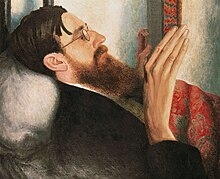
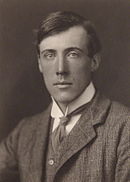
The Stephen siblings moved from Kensington to the Borough of Bloomsbury in 1905 at 46 Gordon Square . Here Thoby began to establish Thursday as a jour fixe for a get-together with his friends. This custom laid the foundation of the Bloomsbury Group , made up in part of members of the Cambridge Apostles . In addition to Virginia, this circle included literary figures such as Saxon Sydney-Turner , David Herbert Lawrence , Lytton Strachey , Leonard Woolf, painters such as Mark Gertler , Duncan Grant , Roger Fry and Virginia's sister Vanessa, critics such as Clive Bell and Desmond MacCarthy , and scholars such as John Maynard Keynes and Bertrand Russell .
In this intellectual circle—she and Vanessa were the only women besides Mary MacCarthy— Virginia was grateful to be able to participate in discussions and to free herself from the moral shackles of her upbringing. That same year, Virginia began writing for various newspapers and magazines; her contribution to the Times Literary Supplement lasted until the end of her life. From the end of the year until 1907 she taught English literature and history at Morley College, an educational institution for working adults.
On November 20, 1906, Thoby Stephen, Virginia's elder brother, contracted typhoid fever while traveling through Greece and died soon after his return at the age of 26—a loss Virginia bore greatly. Shortly thereafter, Vanessa became engaged to Clive Bell; they were married on February 7, 1907 and stayed in the Gordon Square house, while Virginia and Adrian Stephen moved into the house at 29 Fitzroy Square , also in the Borough of Bloomsbury.
The jour fixe of the “Bloomsberries” thus had two bases; Vanessa Bell's salon was initially the more progressive. The tone became more relaxed, the participants addressed each other by their first names, the conversations were not only intellectual in nature, but carried human warmth. English philistinism was the enemy they wanted to fight together, in literature, art and sex.
The following year Virginia made a trip to Siena and Perugia and returned to Great Britain after a stay in Paris. In February 1909, despite his homosexuality, Lytton Strachey proposed to her, which Virginia accepted. However, Strachey changed his mind and they both agreed to forget the proposal.
In the summer of 1909, Virginia made the acquaintance of Lady Ottoline Morrell , an aristocrat and patron of the arts. She joined the Bloomsbury circle and fascinated with her extravagant appearance. Their exotic lifestyle influenced the group, and members happily accepted invitations to their home in Bedford Square on Thursdays at ten o'clock , where visitors such as DH Lawrence and Winston Churchill found themselves in the drawing room. In 1915 her home at Garsington Manor near Oxford became a meeting place for the "Bloomsberries". Virginia created a literary monument to Ottoline Morrell in her novel Mrs Dalloway , which she called the "Garsington novel".
Also in 1909 Virginia Stephen inherited £2500 from her aunt Caroline Emelia Stephen (1834–1909); the inheritance made it easier for her to continue her writing career.
The Dreadnought Prank
On February 10, 1910, Virginia, along with Duncan Grant, her brother Adrian Stephen, and three other "Bloomsberries" staged the Dreadnought Prank , which led to an official inquiry in the House of Lords. The force traveled to Weymouth in an adventurous elevator after registering with a successfully forged telegram to the warship HMS Dreadnought . Virginia, Duncan and two of their friends wore oriental fantasy clothing, glued-on beards and black make-up beyond recognition. They toured HMS Dreadnought at the invitation of the warship's Commander-in-Chief, as a delegation of four princely diplomats from Abyssinia , a member of the British Foreign Office and an interpreter . The fun was successful: a deputation led the delegation through the top-secret ship, the flags were hoisted, and the band played in their honor. However, she played the national anthem of Zanzibar , since the Abyssinian one could not be found. The royal group conversed in a smattering of Swahili , and the interpreter spoke a gibberish of a few lines from Virgil . Luckily for her, the only crew member whose native language was Swahili was not on board that day.
A photo of the reception was sent by group member Horace Cole to the Daily Mirror , which published it. He also personally went to the Foreign Office to report the prank. The “Bloomsberries” wanted to mock the bureaucracy and the “ Empire ” with their coup, which they did with regard to the name of the ship, “Dreadnought” (fear nothing) , which was also the prototype for a whole series of new combat ship types with the same name, also in the pun sense succeeded; insofar it was a double embarrassment for the military leadership. The Royal Navy demanded that the instigator Horace Cole be arrested, but to no avail as the group had broken no law. Cole offered to get six hits with the cane on condition that he could hit back. Duncan Grant was kidnapped by three men, received two slaps in a field and returned home on the tube in slippers.
Marriage and novel debut
In 1911 Virginia rented a house in the village of Firle near Lewes in Sussex and christened it Little Talland House in memory of happy Cornish childhood days . However, it was only a stopgap measure, a little later Virginia and Vanessa leased the nearby Asheham house , which Virginia loved very much and where she spent a lot of time between 1912 and 1919. Virginia and Adrian Stephen moved from the London apartment on Fitzroy Square, whose lease expired, to the house at Brunswick Square 38. John Maynard Keynes, his friend Duncan Grant and Leonard Woolf also rented rooms there, much to the dismay of the relatives: " A young unmarried woman surrounded by a horde of young men!”
In January 1912, on the advice of Lytton Strachey, Leonard Woolf proposed to Virginia. He had taken a leave of absence from colonial service and returned to England in June 1911. She was reluctant and again suffered a depressive episode that necessitated admission to Twickenham Hospital. Leonard was not allowed to visit her. Four months later she agreed, although she wrote to Leonard that he was not physically attractive to her. She loves him to the best of her ability. His love for her was the decisive factor in her consent. Virginia wrote to friend Violet Dickinson on June 5, 1912: “I will marry Leonard Woolf. He's Jewish and doesn't have a penny. I'm happier than anyone ever thought possible - [...]" and the next day she and Leonard sent a joint postcard to Lytton Strachey saying, "Ha! Ha!” followed by their signatures.
The marriage took place on August 10, 1912 at St Pancras Registry Office . Leonard retired from colonial service and did various odd jobs; for example, he was secretary to his Bloomsbury friend, the painter Roger Fry, and organized the second Post-Impressionist exhibition at the Grafton Galleries for him. He then found work at the Charity Organization Society and worked as a political book reviewer for the New Statesman. In 1913 he published his first novel, The Village and the Jungle , in which he processed his experiences in colonial service.
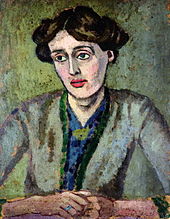
A doctor advised the young couple not to have children - Virginia's health was too weak. Her depression worsened, and on September 9, 1913, Virginia attempted her first suicide using sleeping pills. Nevertheless, she described her marriage as happy - in Leonard she had found an understanding and educated husband who saw her tender relationships with other women with serenity and could endure her frigidity towards him.
The outbreak of the First World War in August 1914 brought no burden for the young couple, apart from a shortage of food, life went on as if nothing had happened. Virginia felt confirmed in her doubts about the male world, since Leonard found the war "pointless and useless", but would not have resisted a draft; due to a congenital limb tremor, he was not drafted into military service.
In 1915 Virginia and Leonard moved to Hogarth House in Richmond near London. That same year, Virginia debuted her novel The Voyage Out , which was published by Duckworth & Co., her half-brother Gerald's publisher. The Voyage Out has clear autobiographical traces.
Foundation of the Hogarth Press
In 1917, the Woolfs founded The Hogarth Press , based on the Omega Workshops founded by Roger Fry in 1913 . They specialized in modern literature from Britain, the United States and Russia . In July 1917, production began shipping Two Stories , each containing a story about the spouses, The Mark on the Wall by Virginia, Three Jews by Leonard Woolf. The couple typeset the 34-page brochure themselves. Not having enough type , the Woolfs typeset two pages, printed them on a second-hand Minerva platen press , untypeset , and then typeset the next two pages. In this way, it took them a good two months to print the edition of 150 copies. The binding , which was also done by hand, then followed .

The publisher's small first work, which features four woodcuts by Dora Carrington , a friend of Lytton Strachey, had already been pre-ordered by 100 friends and acquaintances, and the last copies were sold within two years. Also among the first hand-set works was Prelude by the writer Katherine Mansfield ; however, their friendship was of an ambivalent nature. Mansfield played a double game: she praised The Mark on the Wall to Virginia , but behind her back she called the work banal. By the year 1932, a total of 34 books had been created by hand. Although Hogarth Press became increasingly professional, it wasn't until Virginia's third novel, Jacob 's Room , that it was self-published. In his memoirs, published by Hogarth Press in 1967, Leonard Woolf recalls: "We printed in the pantry, bound the books in the dining room, and interviewed authors, bookbinders and printers in a living room."
Virginia's function at Hogarth Press was to recruit new writers and edit their manuscripts . As she noted in her diary on December 8, 1929: “I read & read & must have finished a 3 foot stack of manuscripts, read carefully along with it; much of it on the border, so it was something to think about.” Leonard was in charge of the business, but he also attracted many writers, mainly from the political and economic fields. Vanessa Bell designed illustrations for Virginia's books and was responsible for the cover design of her works. Kew Gardens , reissued in 1927, was the most attractive publication in the sisters' collaboration.
The Woolfs made a bad decision when they turned down James Joyce's novel Ulysses , which they were offered for publication in April 1918. At the time, only the first chapters were available, but even these were too extensive to be typeset and printed by hand. Because of the obscene content, they couldn't find another printer to take responsibility for the text. Moreover, Virginia was unconvinced by the content, writing to Lytton Strachey on April 23: "First there's a dog p--t, - then there's a man farting, and one can be monotonous even on the subject - besides, I don't think his method, which is sophisticated, means very much more than omitting the explanations and inserting thoughts in dashes: so I don't think we're going to do it.”
Acquisition of Monk's House
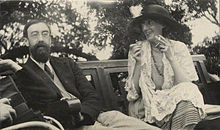
In July 1919 the Woolfs bought a simple cottage in Rodmell ( Sussex ), called the Monk's House ; they had bought it for £700 as Asheham had been fired from them. In the garden stood two huge elms , which all visitors and friends of the house called Virginia & Leonard . The Woolfs made additions to Monk's House and over the years they have imaginatively decorated it with carpets, wallpaper, fabrics, mirrors, tiles and screens by Vanessa Bell and Duncan Grant. A model for the decoration was Vanessa and Duncan's interior design of the Charleston Farmhouse near Firle, six miles from Monk's House, which they rented in 1916. Regular meetings of the "Bloomsberries" took place in both houses.
That same year Virginia Woolf's short stories Kew Gardens were self- published and her second novel Night and Day was published by Duckworth.
In 1922, her novel Jacob's Room ( Jacobs Zimmer ) was published almost at the same time as James Joyce 's Ulysses . In this novel, like Joyce, she worked with the technique of the inner monologue and with this concept broke with the conventional narrative technique. The protagonist Jacob closely resembles her late brother Thoby. The book was a sales success, brought the author recognition in the literary avant-garde scene and invitations from important personalities. Leonard Woolf became feature editor at the weekly Nation and was thus able to contribute to the joint income.
Vita Sackville-West

In December 1922, she met writer Vita Sackville-West , wife of diplomat Harold Nicolson . The friendly relationship developed into a three-year close love affair (1925-1928), which turned into friendship and lasted until Virginia's death. A business relationship developed at the same time: in the Hogarth Press she published Vita's works, for example the novella Passenger to Tehran in 1926 , as well as works by her husband Harold Nicolson, although Virginia did not particularly like Vita's work and described it as having been produced with a "tin pen". . Rather, her appeal lay in her masculine beauty, noble connections, and love of adventure.
Virginia's nephew and biographer, Quentin Bell , described the relationship: "Virginia felt as a lover feels: despondent when she felt neglected, despondent when Vita was away, impatient for letters, in need of Vita's company and living in." the odd mixture of elation and despair that is characteristic of lovers - and one would think only lovers."
Vita Sackville-West's son, Nigel Nicolson , published his mother's letter to her husband in his book Portrait of a Marriage from His Parents' Correspondence: "I love Virginia - who wouldn't?" But […] loving Virginia is something else entirely: something spiritual, something spiritual if you will, a matter of the intellect […] I am deadly afraid of causing physical feelings in her because of the insanity […] I have slept with her (twice), but that's all."
Mrs Dalloway , To the Lighthouse
In 1924 the Woolfs moved back to Bloomsbury and rented their publishing house and flat at 52 Tavistock Square . In the same year, Virginia published her highly acclaimed essay Mr Bennett and Mrs Brown , which came to be a critical reckoning with the traditional art of storytelling and conceptually introduced her probably most important novel Mrs Dalloway , which was published in 1925. Originally, the novel was to be called The Hours , like Stephen Daldry 's later film . What was innovative about it was the narrative technique of stream-of-consciousness , with which she represented what was happening through the world of thoughts, the moods and impressions of the various characters in the novel. She had already tried out this method in Jacob's Room , but perfected it here. Also in 1925 appeared her collection of essays , The Common Reader , which published previously published essays and reviews along with new work, such as the essay on the contemporary American novel.
After the publication of Mrs. Dalloway , Virginia began writing the novel To the Lighthouse on August 6, 1925 , which she was able to complete in January 1927, interrupted by bouts of depression. She originally wanted to call the work an “ elegy ” and not a “novel”. Leonard called it a masterpiece, and she, too, was satisfied with her work: 'Dear me, how beautiful some parts of The Lighthouse are! Soft & supple, & deep, I mean, & not a single wrong word, pages at times.” The Lighthouse is an autobiographical novel that follows the history of the Stephen family. The writing came close to a psychoanalysis , the therapy consisted in storytelling and banned the domination of the parents over her. It's a ghost story of sorts, the story of a haunted house, Talland House in St Ives, although the novel is set on the Isle of Skye . The protagonist Mrs. Ramsay's dark feelings about loneliness and death were also Virginia's feelings.
Orlando
In the spring and summer of 1928, Virginia and Vita undertook an extended tour of France. Orlando appeared in October of the same year . The main character Orlando lives from the 16th to the 20th century, changes her gender from male to female in adulthood and is a poet at the end of the journey through time. This humorous novel is considered Virginia's love letter to Vita Sackville-West, whose personality is reflected in Orlando . Virginia took historical details from Vita's 1922 book Knole and the Sackvilles , which details Vita's birthplace, Knole House in Kent , and the history of the Sackvilles. Virginia herself describes the book as cheerful and quick to read; writing it was a vacation for her as a writer and did not pose the travails of other works. In Nigel Nicolson's biography of his parents, he describes Orlando as "the longest and most charming love letter in literature". Largely owned by the National Trust since 1946, visitors to Knole House can currently admire the original Orlando manuscript on display in the Great Hall .
The essay A room by itself

The essay A Room of One's Own was published in October 1929. The clever and witty treatise on the oppressive conditions under which women had to produce literature in the past, and in which Woolf describes Shakespeare's fictional poet sister Judith, has become one of the most cited texts of the women's movement:
- “[…] And if each of us has five hundred [pounds] a year, and a room to ourselves; when we are used to the freedom and the courage to write exactly what we think; […] then this opportunity will come and the dead poetess who was Shakespeare's sister will take on the body she has so often shed.” These are the basic material conditions under which women can produce literature just as successfully as men. In it, she also formulated some views on artistic creativity that guided her own writing. The book became a success; 22,000 copies were sold in England and America within half a year.
Composer and suffragette Ethel Smyth , in January 1930, requested Virginia's participation in a BBC program called Point of Views on the occasion of the publication of A Room of One's Own and declared her admiration for the essay as an important contribution to the emancipation movement. A personal relationship and extensive correspondence developed with Ethel Smyth, who was 24 years her senior. At this point, Vita Sackville-West moved to Sissinghurst and, together with her husband Harold Nicolson, devoted herself to the design of her later world-famous garden.
The Waves and Flush
1931 saw the publication of The Waves , the third and final of her so-called experimental novels, after Mrs Dalloway and To the Lighthouse . Virginia conceived and wrote The Waves at the same time as The Lighthouse , interrupted by the writing of Orlando . Working on it became an almost unbearable exertion, which took a toll on her health. Using a montage technique, the book spans the lives of six people, from childhood to old age, inserted into the course of a beautiful summer's day. In contrast to the critics, the reading public accepted The Waves unreservedly, and after a month the second edition was already being printed.
The 1932 biographical novel Flush , which chronicles the adventures of the cocker spaniel by writer Elizabeth Barrett Browning in London and Florence, is a mixture of fact and fantasy. Flush had the highest first edition of any of her works, reaching 50,000 copies each in England and the United States within a few months .
Freshwater , The Years and Three Guineas
In 1935, Virginia's only play, Freshwater , was staged at Vanessa Bell's London studio. In it, she addressed the life story of her great-aunt, Victorian photographer Julia Margaret Cameron . The performance was in front of friends: Vanessa Bell played Mrs Cameron, Leonard Woolf played Mr Cameron, and Duncan Grant took on the role of George Frederic Watts . Vanessa's children, Julian and Angelica Bell , were Lord Tennyson and Ellen Terry , respectively .
The place Freshwater is on the Isle of Wight , where the Camerons had a residence. As early as 1926, Virginia had published a collection of Cameron's photographs with Roger Fry in Harcourt, Brace, New York, entitled: Julia Margaret Cameron. Victorian Photographs of Famous Men & Fair Women . The Woolfs spent the remainder of the year on a European tour intended to cure Virginia of her recurring mental illness.
Virginia's next novel - her most voluminous work - The Years , the history of the Pargiter family of officers and the biographies of their four daughters, appeared in 1937; she had already begun work on it in October 1932 under the working title The Pargiters . In the uncomplicated narrative style, she returned to the tradition of English novels, which she had not used for night and day . Writing was difficult for her, and publication put her under pressure. However, the years became a sales success; the English edition had a circulation of 18,000 copies, and in America it became a bestseller, selling 50,000 copies in the first year.
The analytical material collected by Virginia on society's misogyny not only flowed into The Years , but was also found in the feminist essay Three Guineas , published in June 1938. In this essay, shortly before the Second World War , she connects the patriarchal form of society with militarism , fascism and war. The working title for the essay, planned as early as 1935, was On Being Despised . Virginia did not want the integration of women, but gender equality : "We stand for the rights of everyone - all men and women - to respect the great principles of justice, equality and freedom in their person". Her friends felt the essay was unnecessarily polemical due to its lack of humor, but it should set another milestone in the fight against sexism . She refused an honorary doctorate from the University of Liverpool in 1939 because she had been critical of the "academic machine" throughout her life.
Writer John Lehmann , editor of the Hogarth Press from 1931 to September 1932, bought into the publisher in March 1938 and took over Virginia's shares. However, she continued to contribute to the program design of the publishing house. Lehmann worked with Leonard Woolf as managing directors at the Hogarth Press until 1946. He then founded his own publishing company, "John Lehmann Limited", together with his sister Rosamond .
World War II and Death
After the United Kingdom declared war on Germany on September 3, 1939, the Woolfs decided to live in the Monk's House from now on and travel only twice a month to the publishing house in London. In September 1940, the house at Mecklenburgh Square 37 , which had been her London home since 1939 and also housed the Hogarth Press, was badly damaged by bombs during an air raid by the German Luftwaffe. The Hogarth Press had to be outsourced to Letchworth Garden City .
In May 1940, after Germany's invasion of the Netherlands and Belgium, the Woolfs resolved to die together if there was a German invasion of Britain, since Leonard Woolf was a Jew and a socialist. As a precaution, they bought poison and hoarded petrol in the garage.
On July 25, 1940, Virginia Woolf's biography of the painter and gallery owner Roger Fry, who had died in 1934 and was a friend from Bloomsbury, was published. After completing her last novel , Between the Acts , in 1941 , she fell again into a deep depression . She feared repeating the psychotic episodes of the past, in which she heard voices and was unable to work and read. On 27 March 1941, Leonard Woolf took his wife to a doctor friend in Brighton to discuss treatment options. A day later, on March 28, Virginia committed suicide in the River Ouse at Rodmell near Lewes . As she could swim very well, she packed a large rock in her coat to prevent an eventual rescue. Her body was not found until three weeks later, on April 18. She left two suicide notes, one to her sister Vanessa and one to her husband. This began with the sentence:
- "Honey, I certainly feel like I'm going insane again."
The conclusion was:
- "Everything but the certainty of Your goodness has left me. I can no longer ruin your life. I don't think two people could have been happier than we have been."
Leonard Woolf buried her ashes under the two large elms in the garden, whose branches intertwined, and which they called Leonard and Virginia . He also had a plaque put up with a quote from The Waves :
- "I will throw myself against you, undefeated and unbowed, O Death!"
Leonard Woolf died in 1969 at the age of 88. He was buried like his wife under the elms at Monk's House.
In the garden of Monk's House, which has been managed by the National Trust since 1980 , busts of Virginia Woolf and Leonard Woolf and plaques commemorate the extraordinary writer and publisher couple.

Virginia Woolf's bust by Stephen Tomlin
|
To the factory
Along with Joseph Conrad , James Joyce and DH Lawrence , Virginia Woolf is one of the most important authors of modern English fiction . Above all, her prose work seeks to capture the background and realities of her novel characters with new literary means of expression. In addition to her numerous essays , the experimental and psychological novel represents the author's main work. Woolf uses a montage technique : in the constant alternation of external and internal time, environment and nature, she lets past and present events flow into her texts in a stream of sensations flow in.
The experimental novel
With Jacobs Zimmer , considered by Woolf interpreters to be the author's first “true” experimental novel, she begins to portray the complexity of life in a rhythmic succession of fleeting sensations, scraps of thought, and gestures. Like her contemporaries Joyce and Dorothy Richardson , who followed similar approaches, she uses the inner monologue to present these impressions as they appear in the stream of consciousness of the characters in the novel. However, there is no development: the characters remain trapped in their search for identity between reality and the world of dreams. Man's loneliness in modern mass society thus becomes an essential theme of Woolf's novel.
Inspired by Joyce , Woolf achieves a suspense by contrasting her own point of view with the associations of her characters as a kind of "counterpoint". This is particularly evident in the expressionistic pictorial quality that she uses for landscape descriptions, which contrasts with the pointed character studies of the cool, often soulless city people. Woolf uses stylistic devices that are similar to those of a writer, which were used in the visual arts by the post-impressionists and are particularly evident in the works of Vincent van Gogh , who was her special admiration.
In Mrs Dalloway she honed the storytelling technique she had developed in Jacob's room . The novel is considered a masterpiece of modern storytelling and is often compared to Joyce's Ulysses and Marcel Proust's In Search of Lost Time . In this work, Woolf primarily uses the latest findings in psychoanalysis and refers ironically to Freud's levels of consciousness. In the run-up to the novel, in her 1924 essay Mr Bennett and Mrs Brown , she had proclaimed that the job of a novelist was not "to preach doctrines, or to sing songs, or to glorify the British Empire," but "to fathom the psyche of man “. The critically acclaimed essay provocatively challenged the “ Edwardian techniques” of Bennett , Galsworthy and Wells , which they saw as outdated .
In Mrs Dalloway , she expanded the technique of the stream of consciousness introduced in Jacob's room to include the component of "arbitrariness": The main character can no longer be objectively described as in the traditional novel, but is only defined by the reflection of the (changing) secondary characters and their perception . The reader only learns about the plot through the consciousness of the actors. Similar to Joyce, Woolf limits perception to a certain period of time, in the case of Mrs Dalloway to one day, with which Woolf introduces another stylistic device characteristic of her work: the continuous motif of the passing of time, which in a wavy course of the stream of consciousness – between Alternating present and past – is experienced. Stylistically, Woolf proceeds with the narrative styles and alternates fluently between direct speech with descriptive action and the spoken speech in the inner monologue. In Mrs Dalloway , Woolf uses tempus fugit motifs (burnt out candles or chiming clocks), a significant symbolism that is to be repeated more frequently in her later work. To the Lighthouse consistently continues this psychological narrative technique with linguistic perfection: it makes use of a series of syntactically complex (im)possibilities that make the impression of an objective reality disappear and are an expression of the "wandering and playing of consciousness " . the author or changing, sometimes nameless subjects whose consciousness tends to flow together. The main character is thus reflected in the stream of consciousness of the other characters. A traditional plot is dispensed with, the time continuum divided into three (“time stratification”). The lighthouse itself becomes an ambiguous symbol that can be interpreted as an assimilation "male" superego with groundbreaking constancy or as a place of fixed norms and values and stands in contrast to the constantly changing "female" sea, which acts as a balancing elemental force for both the subconscious flow of things as well as harmony, retreat and new beginnings. Woolf continually juxtaposes these two characters throughout the work and brings them together in the closing sequence of the novel, in the painting by the painter Lily Briscoe. The novel is considered one of Virginia Woolf's "compositionally and linguistically most successful achievements."
Finally, Woolf makes the most radical break with any traditional narrative technique in The Waves : the writer dispenses with a reporting narrator , a tangible plot or a specific setting and subjects the course of events to a precisely defined symbolic cycle of times of the day and seasons. The work consists exclusively of the inner monologues of the six protagonists, who in turn are representatives of a phase of life dominated by certain characteristics or reflect it. The book was rated by critics as an "artificial and unsatisfactory experiment in form and style" and was only later recognized as the logical conclusion to Woolf's narrative experiment. The novel The Waves is in many ways more philosophical than readers have realized, and Virginia Woolf often expressed despair about it.
In her last novel Between the Acts ( Zwischen den Akten ) , which was written against the background of the Second World War, Woolf creates a comical and critical analogy to the animal kingdom: by providing the actors in a village theater performance with carnivalesque -animal traits, she raises the question looking for the origin, the similarities and the differences between humans and animals and looks for the answer in creativity and language skills. She holds up a mirror to the reader with the central question of humanity and thus leaves the answer open. In doing so, she once again uses the trick of reflection: the actual action takes place “between the acts” or “between the lines”. Again the action takes place in one day, and again it makes use of symbolism: this time the bird motif is preferred. The bird symbolizes both beauty and destruction. The posthumously published work combines prose with poetry and dialogue and demonstrates Woolf's continued quest to expand the novel's scope.
The essays
In her ironic, often critical essays, Virginia Woolf prefers to deal with writers such as Jane Austen , George Eliot and Dorothy Wordsworth . Woolf was particularly fascinated by Jane Austen, with whose work her own work was often compared, since Austen's biography, although initially more carefree, shows similarities to her own. Both works were created at the end of a literary epoch and should mark a new one. Austen died early, at the peak of her creativity: for Woolf, who doubted herself, Austen's short, completed life's work embodied in its formal perfection a self-determined innocence that her own work (and life) did not possess. In 1925 she dedicated a chapter to Jane Austen in her collection of essays The Common Reader and praised her with sentimental words as "The most perfect artist among women, the writer whose books are immortal, died just as she was beginning to feel confidence in her own success." ("The perfect artist among women, the writer whose books are immortal, died just beginning to gain confidence in her own success.")
Among Woolf's critics, the 1924 essay Mr Bennett and Mrs Brown is one of the writer's most revealing essays, as it not only breaks with the traditionalists of English literature - Arnold Bennett in particular gets caught in the crossfire of their criticism - but also provides insights into the Character design and the author's handling of identities : the fictional Mrs Brown, as Woolf's alter ego , represents the point of view of her creator, but as a person who can only be perceived reflexively , she remains a mystery. Woolf does not give her Mrs Brown any particular trait: she remains "random" like many other characters in her work. With this, Woolf negates the “real characters” of the Edwardians . Martin Walser calls these figures "Woolfian shells of everyday life that you can't get hold of, at best you can approach them" and refers to the multiple design of the Orlando .
Mr Bennett and Mrs Brown reflects on Roger Fry's impressive first post-impressionist exhibition Manet and the Post-Impressionists in London's Grafton Galleries in late 1910, which became a cultural event. With this event, Woolf dated a cultural paradigm shift : "On or about December 1910 human character changed," she wrote in the essay and transferred the emergence of painting into modernism to literature: the epochal replacement of the Edwardians by the Bloomsberries and the avant-garde Vorticists around Ezra Pound .
The most cited text of the new women's movement , Woolf's 1929 essay A Room of One's Own , was not translated into German until 1978. In it, Woolf already anticipated the thesis of the 1968 movement about the political character of the private sphere.
diaries and letters
Virginia Woolf had kept a systematic diary since she was a child and from 1915 onwards . Parts of it were published for the first time in 1953. From 1977 to 1984 the entire records were published in five volumes. Her extensive correspondence was also published, six volumes appeared between 1975 and 1980. Diaries and letters are now available in German translation. For many readers, this estate is at least as important as the works published during one's lifetime. They reveal that Virginia suffered from depression while writing her texts, for example while working on Mrs Dalloway : "[...] And then again, as the manuscript grows, I have the old fear of it. I will read it & find it pale. […] But if this book proves something, then that I can only write in this way & and will always stick to it, but keep exploring & thank God I won't be bored for a moment. But this slight depression – where does it come from?” She showed a similarly weak self-confidence when her books were published. Fear of negative criticism and uncertainty about her own work often triggered flare-ups.
reception
"It is writing, that gives me my proportion."
During her lifetime, Virginia Woolf's work was hardly known beyond the circle of writers in the English-speaking cultural area. Since the 1970s it has increasingly inspired various social and emancipatory movements in Europe and the USA; as a result, the literary work and its author increasingly attracted public interest.
effects during lifetime
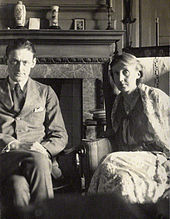
In her country of birth, Virginia Woolf, as the daughter of a well-known cleric and man of letters, early became the focus of the English press due to the scandalous dreadnought prank ; At the latest from her debut novel, her own essay-like reviews and Hogarth Press publications by writer friends, such as TS Eliot's Poems (1919), she was recognized as an author and publisher by a larger circle of readers.
Outside of the English-speaking culture, however, Virginia Woolf's work remained largely unknown or at least difficult to access. In 1929, Klaus Mann reviewed the German edition of Mrs Dalloway entitled "A Woman of Fifty Years Old " and reviewed the novel as "a true-to-life work" and "the most radical of the 20th century".
The writer Elio Vittorini , a literary representative of Italian neorealism , received Woolf's Mrs Dalloway in his collection of stories Piccola borghesia published in 1931 and transferred her descriptions of the English upper middle class to the Neapolitan petty bourgeoisie , the so-called " petty bourgeoisie ".
Perception through emancipatory movements
In the search for a literary justification for their nature-related striving for (mostly sexual) liberation , niche cultures and freethinkers such as adherents of neopaganism or hippies in the Anglo-American world often used arbitrary set pieces from Woolf's writings. Among other things, they referred to Woolf's acquaintance with Rupert Brooke or reflected on the general informality of the Bloomsbury Group, which had anticipated the open sexuality of the " Polyamory " proclaimed in the 1960s .
Virginia Woolf was credited to the lesbian and gay movement and later LGBT activists for her carefully crafted androgynous female characters with their multifaceted psychology, the playful shifting of (gender) identities in Mrs Dalloway , Orlando and The Waves , and the distanced sexuality of the author a leading literary figure and stylized as the authority of "female writing", although Woolf cannot be classified in any general gender-specific position. As the female protagonist of "Bloomsbury" and its protest of "Victorians against Victorianism", she shaped the image of emancipation .
In the canon of modern Anglo-American university novels after 1945, an increased interest in the avant-garde psychological narrative style of Woolf's work and its socio-critical and linguistic content developed. This interest propagated from the 1970s through isolated intellectual papers, seminars and scientific symposia and manifested itself in the present with the founding of the International Virginia Woolf Society in Toronto as a coordinating English-speaking network. Supported by the Modern Language Association , current research results on the complex life and work of the writer and her influence on modern language are compiled and examined.
Effects in German-speaking countries

In the German-speaking area after the war, Virginia Woolf's work was initially only known to a "literary elite" and was only noticed by parts of the women's movement in the 1970s and 1980s, whereupon the "identification with weakness [...] as the main theme of Woolf's reception" by parts of the women's movement, "reducing women to being victims", is declared the motto, as Ingrid Strobl criticized in Emma 1980. In the same essay she made a deliberately exaggerated comparison with the younger American writer colleague Sylvia Plath , who also committed suicide and was bound to fail in the role of the “female genius”: “[...] under the cursed burden of being brilliant, it had to tender woman collapse, even the dear, poor sister Plath was like that, how could it be otherwise - it is not in the nature of a woman to step out of line, to achieve great things - how manly!"
criticism
From 1975 to 1980, Nigel Nicolson published letters from Virginia Woolf at Hogarth Press, which, in their subjective selection, face a biographically authentic context, whereby Nicolson in his biography Virginia Woolf , published in 2000, not only describes her work and important role in the women's movement, but also her latent anti-Semitism and xenophobia not spared.

In her diaries, Virginia would occasionally refer to her husband's unloved family as "the Jews," and at the table she would sometimes say: "Give the Jew his food," meaning her husband Leonard. The English professor Hermione Lee , in her profound 1996 biography, reports that anti-Semitism was quite widespread in the English upper class up until the 1930s, and she cites Virginia Woolf's regret at her behavior towards Leonard and his family in a letter to her friend Ethel Smyth of August 2, 1930: "How I hated to marry a Jew... I was such a snob !"
EM Forster , himself a Bloomsbury member for a time, was ambivalent about the influence of the women's movement on Virginia Woolf's work. In a 1941 Rede Lecture at the University of Cambridge , he praised the women's liberation-inspired "ravishing brilliance" of A Room of One's Own , but criticized "that the women's liberation movement is also to blame for the most miserable of her books - the quarrelsome 'Three Guineas' – and the cause of a number of not so good passages in 'Orlando'.” Furthermore, Forster accused the writer of a stereotypical view: “She was convinced that society was made for men, that men's primary occupation consists in shedding blood, making money, issuing orders, and wearing uniforms, and that none of these occupations are admirable.”
appreciations
Woolf found its way into the visual arts of the 20th century. The feminist artist Judy Chicago dedicated one of the 39 place settings at the table to her in her work The Dinner Party . See also the article List of the 999 women of the Heritage Floor .
In her study Sappho and the Virgin Mary: Same – Sex Love and the English Literary Imagination (Between Men – Between Women – Lesbian and Gay Studies) , the Indian author and translator Ruth Vanita presents Virginia Woolf as a “ Sapphic author in dialogue with her contemporaries and ancestors".
On Virginia Woolf's 125th birthday, Fischer Verlag published a comprehensive selection of her letters, which, as Eva Menasse reviewed in Die Zeit , reflects a "Virginia Woolf without shackles", in whose letters "[...] there is no trace of her torments at the writing the novels, which were often journeys to the limits of her sanity.” Die Zeit also noted her trenchant letters as “satirical miniatures” showing both the entertaining, humorous side of Virginia Woolf and contrasting her “intellectual discourses” as also their tendency to please with gossip or to amuse them.
In New York, since the late 1990s, the "Library Way" has led on East 41st Street between Fifth Avenue and Park Avenue to the Stephen A. Schwarzman Building , the largest building in the New York Public Library (NYPL). Embedded in the paving of the pedestrian walkway are 96 rectangular bronze plaques dedicated to important writers and containing quotes from their works. Virginia Woolf is represented with a plaque and a quote from the essay The Leaning Tower : "If you do not tell the truth about yourself you cannot tell it about other people."
On May 2, 2013, King's College London announced that a new building for the college would be called the Virginia Woolf Building in the autumn .
An exhibition of Woolf's life and work ran at London's National Portrait Gallery from July 10 to October 26, 2014 entitled "Virginia Woolf: Art, Life and Vision."
In 2015, 82 international literary critics and scholars chose four of her novels as one of the top 100 British novels . To the Lighthouse is # 2, Mrs Dalloway is #3, The Waves is # 16, and Orlando is #65. George Eliot's Middlemarch tops the list.
Play and Movie Who's Afraid of Virginia Woolf?
Edward Albee's play Who's Afraid of Virginia Woolf? ( Who's Afraid of Virginia Woolf? ) premiered on October 13, 1962 at the Billy Rose Theater in New York . Albee got the idea for this around 1953 or 1954, as he himself says, in view of a series of graffiti in a bar washroom: "One night I was there for a beer and I saw 'Who's Afraid of Virginia Woolf?' scrawled on a mirror, probably with it Soap. When I started writing the play, I couldn't get that line out of my head. And of course "Who's afraid of Virginia Woolf" means the (children's song) "Who's afraid of the big bad wolf"... Who's afraid of a life without false illusions. And I thought it was quite a college intellectual joke.”
An American film adaptation followed in 1966, directed by Mike Nichols . The main actors were Elizabeth Taylor and Richard Burton .
Narrative work (selection)

- 1915: The Voyage Out . Duckworth, London – The Drive Out . Novel. Fischer, Frankfurt am Main 1991, ISBN 3-596-10694-X .
- 1917: The Mark on the Wall . Hogarth Press, Richmond – The Mark on the Wall . In: Stories. Fischer, Frankfurt am Main 1965
- 1919: Kew Gardens . Hogarth Press, Richmond – In the Botanic Gardens . In: Stories. Fischer, Frankfurt am Main 1965
- 1919: Night and Day . Duckworth, London – Night and Day . Novel. Fischer, Frankfurt am Main 1984, ISBN 3-10-092510-6 .
- 1921: Monday or Tuesday . Hogarth Press, Richmond - Monday or Tuesday . In: Stories. Fischer, Frankfurt am Main 1965
- 1922: Jacob's Room . Hogarth Press, Richmond - Jacob's Room . Novel. Fischer, Frankfurt am Main 2000, ISBN 3-596-14578-3 .
- 1925: Mrs. Dalloway . Hogarth Press, London— Mrs. Dalloway . Novel. Fischer, Frankfurt am Main 2003, ISBN 3-596-14002-1 .
- 1925: The Common Reader (1). Hogarth Press, London - The Ordinary Reader (1). essays. Fischer, Frankfurt am Main 1989, ISBN 3-10-092570-X .
- 1926: (co-editor with Roger Fry) Julia Margaret Cameron. Victorian Photographs of Famous Men & Fair Women . New York: Harcourt, Brace
- 1927: To the Lighthouse . Hogarth Press, London – To the Lighthouse . Novel. Fischer, Frankfurt am Main 1993, ISBN 3-596-12019-5 .
- 1928: Orlando . Hogarth Press, London - Orlando - a biography . Fischer, Frankfurt am Main 1992, ISBN 3-596-11331-8 .
- 1929: A Room of One's Own . Hogarth Press, London – A Room of Your Own . Essay. Fischer, Frankfurt am Main 2001, ISBN 3-596-14939-8 .
- 1929: Beau Brummel . Short story for BBC Radio.- Translated from English by Tanja Handels. LSD Goettingen 2015, ISBN 978-3-86930-844-9 .
- 1931: The Waves . Hogarth Press, London – The Waves . Novel. Fischer, Frankfurt am Main 1994, ISBN 3-596-12184-1 .
- 1932 The Common Reader (2) - The common reader (2). essays. Fischer, Frankfurt am Main 1990, ISBN 3-596-13649-0 .
- 1933: Flush. A Biography . Hogarth Press, London - Flush - The Story of a Famous Dog . Fischer, Frankfurt am Main 1994, ISBN 3-596-12416-6 .
- 1937: The Years . Hogarth Press, London – The Years . Novel. Fischer, Frankfurt am Main 2002, ISBN 3-596-15521-5 .
- 1938: Three Guineas . Hogarth Press London – Three Guineas . In: A Room of Your Own / Three Guineas. Two essays. Fischer, Frankfurt am Main 2001, ISBN 3-10-092573-4 .
- 1940: Roger Fry. A Biography . Hogarth Press, London; Harcourt Publishers Ltd College Publishers 1976, ISBN 0-15-678520-X .
- 1941: Between the Acts . Hogarth Press, London (published posthumously July 1941) – Between the Files . Novel. Fischer, Frankfurt am Main 1999, ISBN 3-596-14341-1 .
- The Essays of Virginia Woolf . 6 volumes. Edited by Andrew McNeillie. Hogarth Press, London 1986-2011
letters, diaries
- Moments of Being . Unpublished Autobiographical Writings. Edited by Jeanne Schulkind, Brighton 1976; German moments. (Sketches of the Past) Sketched Memories . Deutsche Verlags-Anstalt, Stuttgart 1981 and Fischer Verlag, Frankfurt, ISBN 3-596-25789-1 .
- A Passionate Apprentice: The Early Journals 1897–1909 . Edited by Mitchell A. Leaska. Hogarth Press, London 1990
- The Diary of Virginia Woolf . 5 volumes. Edited by Anne Olivier Bell. Hogarth Press, London 1977-1984
- The Letters of Virginia Woolf . 6 volumes. Edited by Nigel Nicolson and Joanna Trautmann. Hogarth Press, London 1975-1980
- Letters 1. 1888–1927 . Edited by Klaus Reichert and Brigitte Walitzek. Fischer, Frankfurt am Main 2006, ISBN 978-3-10-092556-5 .
- Letters 2. 1928–1941 . Edited by Klaus Reichert and Brigitte Walitzek. Fischer, Frankfurt am Main 2006, ISBN 978-3-10-092564-0 .
- Diaries, Volume 1. 1915–1919 . Edited by Klaus Reichert. Fischer, Frankfurt am Main 1990, ISBN 3-10-092552-1 .
- Diaries, Volume 2. 1920–1924 . Edited by Klaus Reichert. Fischer, Frankfurt am Main 1994, ISBN 3-10-092555-6 .
- Diaries, Volume 3. 1925–1930 . Edited by Klaus Reichert. Fischer, Frankfurt am Main 1999, ISBN 3-10-092559-9 .
- Diaries, Volume 4. 1931–1935 . Edited by Klaus Reichert. Fischer, Frankfurt am Main 2003, ISBN 3-10-092562-9 .
- Diaries, Volume 5. 1936–1941 . Edited by Klaus Reichert, Fischer, Frankfurt am Main 2008, ISBN 978-3-10-092566-4 .
- moments of existence. Autobiographical Sketches . Translated by Brigitte Walitzek, ed. by Klaus Reichert, S. Fischer Verlag, Frankfurt am Main 2012, ISBN 978-3-10-092522-0 .
- Letter to a young poet. Translated by Tanja Handels. Steidl Verlag (LSD), Goettingen 2019, ISBN 978-3-86930-947-7 .
Virginia Woolf wrote about 500 other essays, reviews and prose sketches.
When selecting the German reading, it should be noted that Virginia Woolf's works have been available in new translations since 1989. They were edited and (re)commented by Klaus Reichert.
secondary literature
German literature and translations from English:
- Susanne Amrain : So secret and familiar. Virginia Woolf and Vita Sackville-West . Suhrkamp, Frankfurt am Main 1998, ISBN 3-518-39311-1 .
- Ingeborg Badenhausen: The language of Virginia Woolfs: A contribution to the style of the modern English novel. Dissertation, Marburg 1932
- Quentin Bell : Virginia Woolf. A Biography . Suhrkamp Verlag , Frankfurt am Main 1982, ISBN 3-518-37253-X .
- Luise Berg-Ehlers: The Gardens of Virginia Woolf . Nicolai Verlag, Berlin 2004, ISBN 3-87584-378-9 .
- Louise DeSalvoVirginia Woolf. The Impact of Sexual Abuse on Her Life and Work . Fischer Verlag, Frankfurt am Main 2002, ISBN 3-596-10566-8 .
- Alexandra HarrisVirginia Woolf. from the English by Tanja Handels and Ursula Wulfekamp. LSD in Steidl Verlag, Göttingen 2015, ISBN 978-3-86930-835-7 .
- Jürgen Klein : Virginia Woolf: Genius - Tragedy - Emancipation , Heyne Verlag, Munich 1984, 2nd edition 1992, ISBN 3-453-55115-X .
- Hermione Lee : Virginia Woolf. a life . German by Holger Fliessbach. Fischer Verlag, Frankfurt am Main 1999. Paperback 2006: ISBN 3-596-17374-4 .
- Nigel Nicolson : Portrait of a Marriage. Harold Nicolson and Vita Sackville-West. Ullstein Verlag, Berlin 2002, ISBN 3-548-30387-0 .
- Nigel Nicolson: Virginia Woolf . Claassen Verlag, Munich 2001, ISBN 3-546-00293-8 .
- Frances SpaldingVirginia Woolf. Life, Art & Visions ; Original title: Virginia Woolf: Art, Life and Vision . Translated from the English by Ursula Wulfekamp with the collaboration of Matthias Wolf. Sieveking, Munich 2016, ISBN 978-3-944874-46-3 .
- George Spater & Ian Parsons. Portrait of an unusual marriage. Virginia & Leonard Woolf [= A marriage of true minds ]. Translated from English by Barbara Scriba-Sethe. Foreword by Quentin Bell. Revised new edition. Fischer Verlag, Frankfurt am Main 2002, ISBN 3-596-13445-5 . The original English edition was published in 1977 by Jonathan Cape Ltd./The Hogarth Press, London. George Spater cataloged the Woolf archive. Ian Parsons was friend and business partner of Leonard Woolf after the merger of Hogarth Press with Chatto & Windus
- Ursula Voss: Bertrand Russell and Lady Ottoline Morrell. A love against philosophy . Rowohlt • Berlin Verlag, Reinbek 1999, ISBN 3-87134-310-2 .
- Werner Waldmann: Virginia Woolf: with self-testimonies and pictorial documents. Rowohlt, Reinbek, 12th edition 2006, ISBN 3-499-50323-9 .
- Helmut Winter: Virginia and Leonard Woolf . Rowohlt • Berlin Verlag, Berlin, 1999, ISBN 3-87134-352-8 .
- Leonard Woolf : My Life with Virginia. memories . Fischer Verlag, Frankfurt am Main 2003, ISBN 3-596-25686-0 .
- Caroline Zoob: The Garden of Virginia Woolf: A Committed Writer's Source of Inspiration [= Virginia Woolf's Garden. Country Planting at a Writer's Retreat ], photographs by Caroline Arber, foreword by Cecil Woolf, translated by Claudia Arlinghaus. Deutsche Verlags-Anstalt, Munich 2013, ISBN 978-3-421-03937-8 .
Fiction :
- Michael Kumpfmüller: Ah, Virginia . Kiepenheuer & Witsch, Cologne 2020, ISBN 978-3-462-04921-3 .
English literature:
- Thomas C. Caramagno: The Flight of the Mind: Virginia Woolf's Art and Manic-depressive Illness . University of California Press; New Ed edition, Ewing, NJ 1996, ISBN 0-520-20504-9 .
- Anthony Curtis: Virginia Woolf: Bloomsbury and beyond. London: House Books, 2006, ISBN 1-904950-23-X .
- Ralph Freedman (ed.): Virginia Woolf: Revaluation and Continuity. University of California Press, Berkeley 2020, ISBN 978-0-520-30282-2 .
- Gillian Gill: Virginia Woolf: And the Women Who Shaped Her World. Boston, New York, Houghton Mifflin Harcourt 2019, ISBN 978-1-328-68395-3 .
- Jane Goldman: The Feminist Aesthetics of Virginia Woolf: Modernism, Post-Impressionism and the Politics of the Visual . Cambridge University Press, reissued 2001, ISBN 0-521-79458-7 .
- Stefanie Heine: Visible Words and Chromatic Pulse. Virginia Woolf's Writing, Impressionist Painting, Maurice Blanchot's Image . Turia + Kant, Vienna/Berlin 2014, ISBN 978-3-85132-742-7 .
- Jean Moorcroft Wilson: Virginia Woolf and Anti-Semitism. Cecil Woolf, London 1995, ISBN 1-897967-40-3 .
- Kay Redfield Jamison: Touched with Fire: Manic-Depressive Illness and The Artistic Temperament . The Free Press, New York 1993, ISBN 0-02-916030-8 .
- Susan Sellers: Vanessa and Virginia . [Fictional Biography]. Two Ravens, 2008; Houghton Mifflin Harcourt, Boston 2009, ISBN 978-0-15-101474-3 .
- NC Thakur: The Symbolism of Virginia Woolf . Oxford University Press, London 1965
This book served as a template for the film The Hours :
- Michael Cunningham: The Hours . btb Verlag 2001, ISBN 3-442-72629-8 . Three seemingly unrelated storylines feature Virginia Woolf in the 1920s, Laura Brown in 1950s California, and Clarissa Vaughan in 1990s New York. They are linked via the character of Mrs Dalloway created by Virginia Woolf.
film adaptations
- Freak Orlando is a 1981 German drama film directed by Ulrike Ottinger and adapted from Virginia Woolf's novel Orlando .
- To the Lighthouse: 1983 film starring Rosemary Harris , Michael Gough , Suzanne Berti and Kenneth Branagh .
- Orlando based on the novel of the same name by Virginia Woolf. Written and directed by Sally Potter . With Tilda Swinton (Orlando), Billy Zane (Shelmerdine), Lothaire Bluteau (Khan), Quentin Crisp (Queen Elizabeth I), Heathcote Williams (Nick Greene), Charlotte Valandrey (Sasha). Country: Great Britain, Russia, France, Italy, Netherlands. Year: 1992.
- Mrs Dalloway . Based on the novel of the same name by Virginia Woolf. Directed by Marleen Gorris . Book: Eileen Atkings. Camera: Sue Gibson. Music: Ilona Sekacz. Starring Vanessa Redgrave (Mrs. Dalloway), Natascha McElhone (Young Mrs. Dalloway), Rupert Graves (Septimus Warren Smith), Michael Kitchen (Peter Walsh), Alan Cox (Young Peter Walsh), Lena Headey (Young Sally), Sarah Bade (elder Sally – Lady Rosseter). Country: UK/NL. Year: 1997.
- The Hours - From Eternity to Eternity . Based on the novel of the same name by Michael Cunningham. Book: David Hare . Starring Nicole Kidman (Virginia Woolf), Julianne Moore (Laura Brown), Meryl Streep (Clarissa Vaughan), Stephen Dillane (Leonard Woolf), Miranda Richardson (Vanessa Bell), George Loftus (Quentin Bell), Charley Ramm (Julian Bell), Sophie Wyburd (Angelica Bell), Lyndsey Marshal (Lottie Hope), Linda Bassett (Nelly Boxall), Christian Coulson (Ralph Partridge), Michael Culkin (Doctor), John C. Reilly (Dan Brown), Jack Rovello (Richie Brown), Toni Collette (Kitty Barlowe), Margo Martindale (Mrs. Latch), Colin Stinton (Hotel Clerk), Ed Harris (Richard Brown), Allison Janney (Sally Lester), Claire Danes (Julia Vaughan), Jeff Daniels (Louis Waters), Eileen Atkins (Barbara), Carmen De Lavallade (Clarissa's Neighbor), Daniel Brocklebank (Rodney). Country: United States. Year: 2002.
- Vita & Virginia (2018 feature film) filmed the relationship between Vita Sackville-West and Virginia Woolf. Vita Sackville-West was played by Gemma Arterton and Virginia Woolf by Elizabeth Debicki .
Readings / audio books
- Orlando. A full reading of the novel. Narrator: Sissy Höfferer . 8 CDs, total running time 525 minutes. The Hörverlag / Sender Freies Berlin 2002, ISBN 978-3-89584-591-8 .
- The waves. Reading with Gert Westphal , Gustl Haneke and others. 2 CDs, total running time 102 minutes. Audio Verlag / SWR, 2005, ISBN 978-3-89813-288-6 .
- Mrs Dalloway. Abridged reading of the novel. Narrator: Angela Winkler . 5 CDs, total running time approx. 358 minutes. The Hörverlag / Sender Freies Berlin, 2001, ISBN 978-3-89584-547-5 .
- sketch of the past. read by Sophie Rois . 3 CDs, total running time 204 minutes. Argon Verlag/Hessischer Rundfunk, 2013, ISBN 978-3-8398-1237-2 .
- To the lighthouse. Voiced by Rosel Zech . 5 CDs. L&M Publishers, 2002, ISBN 978-3-89849-646-9 .
- A private room. Complete reading by Erika Pluhar . 4 CDs. RH Audio Editions, 2007, ISBN 978-3-86604-520-0 .
radio play adaptations
- Jacob's room . Audio play in four parts. With Friedhelm Ptok , Britta Hammelstein, Wiebke Puls , Sylvana Krappatsch , Annette Paulmann, Benedikt Lückenhaus, Alexander Lückenhaus, Andrea Wenzl, Caroline Ebner, Sabine Kastius, Hans Kremer , Johannes Zirner, Stefan Merki. Translation and editing: Gaby Hartel, composition: Jakob Diehl, direction: Katja Langenbach. BR radio play and media art 2012. As a podcast/download in the BR radio play pool. Audio book edition (4 CDs): Der Hörverlag. ISBN 978-3-8445-1119-2 .
- Orlando . A Biography . Radio play in six parts. With Gabriel Raab , Vera Weisbrod , Wiebke Puls , Paul Herwig , Brigitte Hobmeier , Hans Kremer , Georgia Stahl and others. Translation and editing: Gaby Hartel, composition: Ulrike Haage , director: Katja Langenbach. BR – radio play and media art 2013. As a podcast/download in the BR radio play pool. Audio book edition (6 CDs): Der Hörverlag. ISBN 978-3-8445-1380-6 .
- To the lighthouse . Audio play in three parts. With Zoe Hutmacher, Wiebke Puls , Irina Wanka (narrators), Krista Posch (Mrs Ramsay), Walter Hess (Mr Ramsay), Caroline Ebner (Lily Briscoe), Shenja Lacher (Charles Tansley), Julia Loibl (Prue), Christian Löber ( Andrew), Peter Brombacher (Mr. Banks), Moritz Zehner. Processing: Gaby Hartel, composition: Ulrike Haage , director: Katja Langenbach. BR radio play and media art 2016. As a podcast/download in the BR radio play pool. Audio book edition (3 CDs): radio play. The audio publisher. Munich 2017, ISBN 978-3-8445-2553-3 .
web links
- Literature by and about Virginia Woolf in the German National Library catalogue
- Works by and about Virginia Woolf in the German Digital Library
- Claudia Prinz: Virginia Woolf. Tabular curriculum vitae in LeMO ( DHM and HdG )
- Virginia Woolf. In: FemBio. Women's biographical research (with references and quotations).
- Virginia Woolf at the Internet Movie Database
- UK Virginia Woolf Society website
- Home page of the International Virginia Woolf Society (Toronto )
- Index of Hogarth Press handprints with book cover illustrations
- Wieland Freund : The eleven elkhounds of the Virginia Woolf . In: The World . January 20, 2007
- Elsemarie Maletzke : Through Sussex and Kent - in the footsteps of Virginia Woolf and her circle of friends . In: Die Zeit , No. 17, 1998
- Works by Virginia Woolf in the Gutenberg-DE project
- Andrea Klasen: Virginia Woolf, British writer (day of death, March 28, 1941) In: Zeitzeichen on WDR 5 of March 28, 2021, ARD Audiothek , retrieved on July 11, 2021.
itemizations
- ↑ Hermione Lee: Virginia Woolf. one life p. 237.
- ↑ Clues to Early Sexual Abuse in Literature by Lenore C. Terr, MD
- ↑ Hermione Lee: Virginia Woolf. one life p. 215.
- ↑ Kay Redfield Jamison: Touched with Fire - Manic-Depressive Illness and the Artistic Temperament. Simon & Schuster 1993, pp. 224–228, pp. 235–236.
- ↑ Thomas Caramagno: The Flight of the Mind - Virginia Woolf's Art and Manic-Depressive Illness. University of California Press, Berkeley, 1992, archived from the original on April 17, 2003 ; retrieved 8 October 2012 .
- ↑ Hermione Lee: Virginia Woolf. one life p. 106.
- ↑ A Sketch of the Past (new: Sketched Memories). In: moments. Stuttgart 1981, p. 150.
- ↑ Thomas Millie Dow , cornwallartists.org
- ↑ Ursula Voss: Bertrand Russell and Ottoline Morrell. A love against philosophy. p. 166.
- ↑ Caroline Emelia Stephen. smith.edu, archived from the original on December 26, 2008 ; retrieved December 17, 2009 .
- ↑ The Dreadnought Hoax
- ↑ Hermione Lee: Virginia Woolf. one life p. 376 ff.
- ↑ Werner Waldmann: Virginia Woolf. Reinbek 2006, p. 63.
- ↑ Werner Waldmann: Virginia Woolf. Reinbek 2006, p. 71.
- ↑ Helmut Winter: Virginia and Leonard Woolf. Berlin 1999, p. 61 f.
- ↑ Omega Lives. The Omega Workshops & the Hogarth Press ( Memento of June 26, 2010 at the Internet Archive ) (PDF; 2.3 MB), chapin.williams.edu, accessed December 12, 2011.
- ↑ Werner Waldmann: Virginia Woolf. Reinbek 2006, p. 82 f.
- ↑ Hermione Lee: Virginia Woolf. One Life p. 512.
- ^ a b Steve King: Eliot and the Woolfs . (accessed January 6, 2008)
- ↑ Georde Spater, Ion Parsons: Portrait of an Unusual Marriage. Frankfurt am Main 2002, p. 158 f.
- ↑ Hermione Lee: Virginia Woolf. one life p. 513.
- ↑ Nigel Nicolson: Vita, Virginia and Vanessa. In: Christiane Frick-Gerke (ed.): Inspiration Bloomsbury. The circle around Virginia Woolf . Fischer, Frankfurt am Main 2003, pp. 165–173.
- ↑ Virginia Woolf to Jacques Raverat, December 26, 1924.
- ↑ Quentin Bell: Virginia Woolf. A Biography . The Hogarth Press, London 1972, English edition in two volumes, Vol. 2, p. 117.
- ↑ George Spater, Ian Parsons: Portrait of an Unusual Marriage. Frankfurt am Main 2002, p. 205 f.
- ↑ Diary March 21, 1927, 3
- ↑ Hermione Lee: Virginia Woolf. one life p. 630.
- ↑ Nigel Nicolson: Portrait of a Marriage. Harold Nicolson and Vita Sackville-West .
- ↑ Vita Sackville West and Knole , nationaltrust.org.uk
- ↑ A room of your own. p. 130.
- ↑ Hermione Lee: Virginia Woolf. one life p. 758 ff.
- ↑ Spater/Parsons: Portrait of an unusual marriage. p. 218 ff.
- ↑ Hermione Lee: Virginia Woolf. one life p. 830.
- ↑ Woolf, Three Guineas. p. 158.
- ↑ Quentin Bell: Virginia Woolf. p. 504 f.
- ↑ Hermione Lee: Virginia Woolf. one life p. 993.
- ↑ Wilfried Dittmar in Main works of English literature - individual representations and interpretations . Kindler, Munich 1975, p. 456.
- ↑ Wilfried F. Schoeller in Main works of English literature - individual representations and interpretations. p. 458 f.
- ↑ Erich Auerbach : Mimesis. (1946) 10th edition, Tübingen, Basel 2001, p. 498 f.
- ↑ Walter Kluge in Main works of English literature - individual representations and interpretations. p. 461.
- ↑ Walter Kluge in Main works of English literature - individual representations and interpretations. p. 467.
- ↑ Christopher Ames: Carnivalesque comedy in 'Between the Acts.' – novel by woman author Virginia Woolf ( memento of July 8, 2012 at archive.today web archive ). (accessed February 12, 2008)
- ↑ Sabine Menninghaus: Concepts of artistic transformation: scientific analogies in Aldous Huxley , James Joyce and Virginia Woolf . Münster 2000, p. 31 ff.
- ↑ Virginia Woolf . University of Duisburg-Essen (accessed January 2, 2008)
- ↑ Virginia Woolf: The Common Reader. The first series - Chapter 12: Jane Austen . E-Book , University of Adelaide (accessed 3 January 2008)
- ↑ Martin Walser: Identity and Writing: A Festschrift for Martin Walser - lecture series at the University of Hildesheim in the winter semester 1996/97 ; Georg Olms Verlag, Hildesheim 1997, ISBN 3-487-10322-2 , p. 74 ff.
- ↑ "Mr Bennett and Mrs Brown" in Collected Essays , Vol. 1, London 1968, p. 320.
- ↑ Hanno Ehrlicher: The Art of Destruction: Violent fantasies and manifestation practices of European avant-gardes. FU Berlin 2001, ISBN 3-05-003646-X , p. 252.
- ↑ Diary entry of August 2, 1924. In: Virginia Woolf. The reading book. p. 428 f.
- ↑ a b Tanja Langer: The narrative prose is a lady . In: The World . November 20, 1999 (accessed November 18, 2008)
- ↑ Master of Prose in Italy . University of Hull Archives : Review in The New York Times Book Review of 10 April 1932.
- ↑ William Pryor, The Living Memes and Jeans of Bloomsbury and Neo-Paganism . International Virginia Woolf Conference at Smith College , Massachusetts , USA, 2003 (accessed January 4, 2008)
- ↑ Virginia Woolf . In: Fyne Times Gay and Lesbian Magazine, UK
- ↑ Jutta Duhm-Heitzmann: Ecstasy! Where is the post office? . In: The time. No. 18/1991 (accessed January 4, 2008)
- ↑ The International Virginia Woolf Society
- ↑ Ingrid Strobl: Virginia Woolf - Not just the beautiful picture . ( Memento of August 23, 2007 at the Internet Archive ) In: Emma. January 1980 (accessed October 8, 2012)
- ↑ Nigel Nicolson, Joanne Trautmann: The Letters of Virginia Woolf I–VI . Hogarth Press 1975-1980
- ↑ John Gross: "Mr. Virginia Woolf" . (Review)
- ↑ Hermione Lee: Virginia Woolf. one life p. 414.
- ↑ Werner Waldmann: Virginia Woolf. p. 139.
- ↑ Elizabeth A. Sackler Center for Feminist Art: The Dinner Party. Place Setting: Virginia Woolf. Brooklyn Museum, April 13, 2007. Retrieved April 25, 2014 (English).
- ↑ Ruth Vanita: Sappho and the Virgin Mary: Same-Sex Love and the English Literary Imagination (Between Men-Between Women – Lesbian and Gay Studies) . Columbia University Press, New York 1997, ISBN 0-231-10550-9 .
- ↑ Eva Menasse: On the umbilical cord . In: The time. No. 40/2006, September 28, 2006 (accessed January 4, 2008)
- ↑ Matthew J. Boylan, The Road to the Library is Paved with Inspired Quotations , lj.libraryjournal.com, July 5, 2012, accessed May 4, 2014.
- ↑ King's College London - Woolf honored by new building , www.kcl.ac.uk, accessed 10 August 2013.
- ↑ Will Gompertz, Virginia Woolf: Her life in pictures , bbc.com, 9 July 2014, accessed 10 July 2014.
- ↑ The Guardian:The best British novel of all times – have international critics found it? , retrieved 2 January 2016.
- ↑ Interview with Edward Albee ( Memento of May 20, 2006 at the Internet Archive ), by: William Flanegan, in: The Art of Theater, no. 4 , The Paris Review , 1966 (English; PDF file; 277 kB)
- ↑ "The edition of the Collected Works of Virginia Woolf was begun in 1989. It includes all novels, short prose and biographies as well as all diaries and a selection of letters and essays. The novels are presented in new translations that more closely approximate the syntactic and rhythmic style of the original. Most of the other works are published in German for the first time in this edition.” Folder from S. Fischer and Fischer Taschenbuch Verlag, July 1997.
- ↑ BR Radio Play Pool – Virginia Woolf, Jacobs Zimmer (4 parts)
- ↑ BR Radio Play Pool – Virginia Woolf, Orlando (6 parts)
- ↑ BR Radio Play Pool – Virginia Woolf, To the Lighthouse (3 parts)
- ↑ Sylvia Prahl: The merciless passage of time. In: Taz online, August 5, 2017.
| personal data | |
|---|---|
| SURNAME | Woolf, Virginia |
| ALTERNATIVE NAMES | Stephen, Adeline Virginia |
| BRIEF DESCRIPTION | British writer and publisher |
| BIRTH DATE | January 25, 1882 |
| PLACE OF BIRTH | London |
| DATE OF DEATH | March 28, 1941 |
| PLACE OF DEATH | at Rodmell , Lewes , Sussex |


